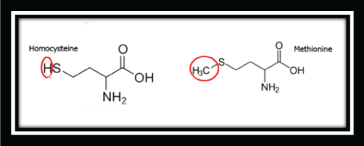Hibbard in 1964 was the first to describe an association between spontaneous abortion and maternal folate deficiency due to defective folate metabolism [1].
Homocysteine (Hcy) is an essential amino acid required for the growth of cells and tissues. Homocysteine (Hcy) is an intermediate product formed by the breakdown of methionine the aid of certain B-vitamins. Homocysteine remethylation to methionine is dependant on both folate and cobalamin (Figure 1) and may undergo transsulfuration to cysteine and cystathionine [2]. Enzyme deficiencies involved in the remethylation of homocysteine result in hyperhomocysteinemia [3]. Elevated homocysteine can occur in cases of dietary or genetic vitamin deficiency, or reduced enzyme activities [4].
 Figure 1: Homocysteine and Methionine. View Figure 1
Figure 1: Homocysteine and Methionine. View Figure 1
Homocysteine levels are typically higher in men than women, and increase with age. Common levels in Western populations are 10 to 12 μmol/L, and levels of 20 μmol/L are found in populations with low B-vitamin intakes or in the elderly [5]. Abnormally high levels of homocysteine in the serum, above 15 μmol/L, are a medical condition called hyperhomocysteinemia [6].
Elevated plasma homocysteine levels are associated with an increased risk of atherosclerosis and thrombosis, as well as a variety of other pathologies such as birth defects, osteoporosis, diabetes and renal disease. The prognostic ability of plasma homocysteine level as a hazard factor for atherothrombotic orders raised the appealing hypothesis that reduction of homocysteine levels by vitamin supplementation might result in a commensurate reduction is the risk of atherothrombotic events [7].
Various surveys were focused on the connection between PCOS and genetic factors related to insulin resistance and type 2 diabetes mellitus [8]. In addition, a high risk of premature Coronary Artery Disease (CAD) has been described in patients with PCOS [9]. However, the exact etiology has not even been fully identified. To identify the pathogenesis for CAD in PCOS patients, several genetic studies have related to risk factors for CAD [10,11]. The risk factors associated with CAD are smoking, diabetes, family history, and increased homocysteine (Hcy) levels in PCOS [12]. Among the risk factors, it was described that the homocysteine level is extremely linked to insulin resistance in PCOS patients [13].
In Kazerooni and associates study, they proved to investigate the role of hyperandrogenemia, insulin resistance, and hyperhomocysteinemia as well as inherited and acquired thrombophilias in patients with PCOS who had Recurrent Pregnancy Loss (RPL). The writers establish that patients with PCOS and RPL had higher testosterone, DHEAS, and homocysteine (Hcy) levels than patients without PCOS but with RPL. RPL in those patients with PCOS was also associated with hypofibrinolysis and decreased insulin sensitivity. Kazerooni and coworkers, also observed higher levels of Hcy in patients with RPL than in healthy people [14].
The homocysteine levels of hyperhomocysteinemic women with PCOS were reduced after 3 months of folic acid supplementation, and the rate of decrease was higher among women without insulin resistance [15].
Randeva and associates noted that elevated serum Hcy levels are present in PCOS women, indicating that an alteration in Hcy metabolism may be implicated in the increased risk of CARDIOVASCULAR disease in such patients [16].
In spite of several works, the real mechanism in which Hcy is increased in PCOS patients is not well-read. A bunch of factors affect serum Hcy levels, including age, gender, sex-steroid hormones, Insulin Resistance (IR), Body Mass Index (BMI), and glucose tolerance and chronic inflammation. Increased insulin levels have been taken as a regulating factor of Hcy in which insulin inhibits hepatic cystathionine b-synthase activity that increases serum homocysteine [13].
Follicular fluid also contains Hcy. Disorders of the composition of follicular fluid such as the microenvironment of an oocyte may influence its development. A primary deficiency of natural folate resulting in an increment of the total Hcy concentration may be detrimental to the character of the oocyte, subsequent fertilization, embryo quality, implantation, embryogenesis, and fetal outcome [17].
Despite elevated serum insulin, insulin resistance, and homocysteine levels, and their effects on oocyte numbers and maturation in PCOS patients, there were no differences in follicular parameters and clinical pregnancy rates between hyperinsulinemic and hyperhomocysteinemic PCOS patients and the other groups [18].
In spite of several studies, the real mechanism in which Hcy is increased in PCOS patients is not well-understood. Increased insulin levels have been considered as a modulating factor of Hcy in which insulin inhibits hepatic cystathionine b-synthase activity that increases serum homocysteine [13]. In addition, there was also a positive significant correlation between elevated serum insulin and IR in these patients [19]. Several evidences reported higher levels of sex steroid hormones and androgens in PCOS patients, which may influence the metabolism of Hcy and increase its plasma levels [20].